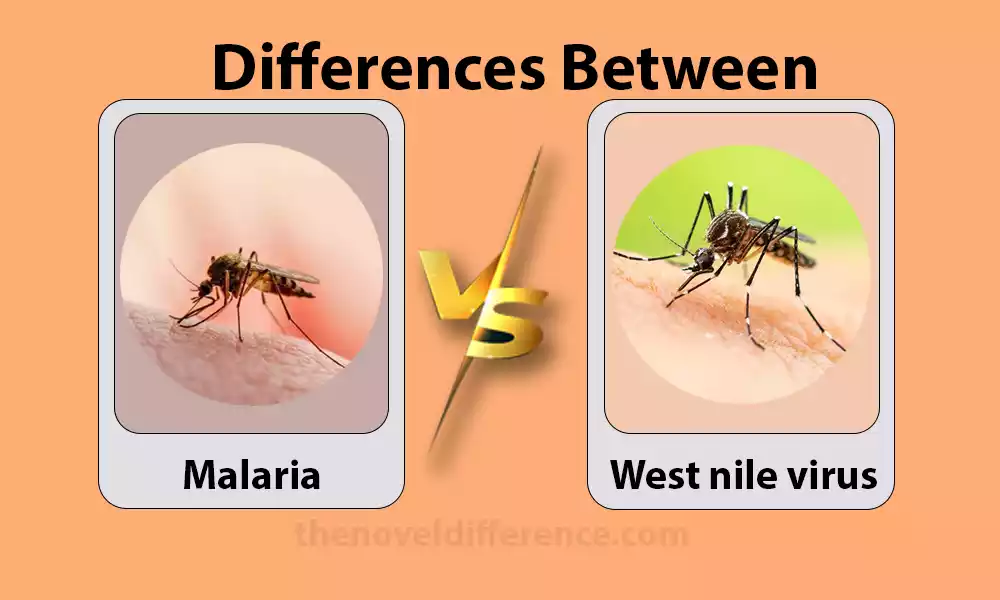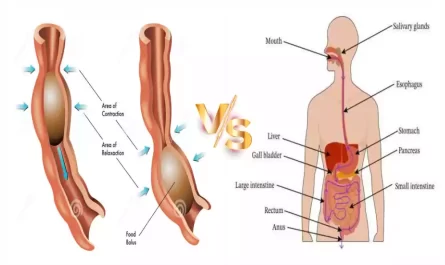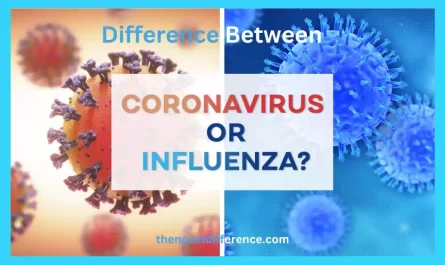Discover the key dissimilarities between malaria and West Nile virus, two prevalent mosquito-borne diseases. Learn about their symptoms, transmission, geographical distribution, prevention, and more. Gain a deeper understanding of these diseases and protect yourself from their impact.
Introduction
Mosquitoes are not only pesky creatures that buzz around us; they also pose a significant threat to human health by transmitting various diseases. Among the numerous ailments they can spread, malaria and West Nile virus stand out as two prominent mosquito-borne diseases.
Although They Share Similarities, Understanding the Differences Between These Diseases is Crucial for Effective Diagnosis, Treatment, and Prevention. We Will Explore the Key Distinctions Between Malaria and West Nile Virus, Shedding Light on Their Symptoms, Transmission, Geographical Distribution, Prevention Strategies, and More.
Importance of understanding the differences between malaria and West Nile virus diseases
Understanding the differences between malaria and West Nile virus is crucial for several reasons:
1. Diagnosis and Treatment: Malaria and West Nile virus require different diagnostic approaches and treatments. Knowing the distinctions helps healthcare professionals accurately diagnose and manage patients, leading to appropriate and timely interventions.
2. Public Health Measures: Understanding the differences allows public health authorities to implement targeted control and prevention strategies. Different mosquito vectors, geographic distributions, and transmission patterns require tailored approaches to reduce the burden of each disease effectively.
3. Prevention Strategies: Knowledge about the differences enables individuals and communities to adopt specific preventive measures. For example, using bed nets and taking antimalarial medications are effective strategies against malaria, while mosquito control and avoiding mosquito bites are crucial for West Nile virus prevention.
4. Surveillance and Monitoring: Differentiating between the Malaria and West Nile Virus diseases aids in surveillance efforts. Accurate surveillance data help public health agencies track disease trends, identify high-risk areas, and allocate resources appropriately.
5. Research and Development: Understanding the distinctions facilitates targeted research on disease mechanisms, vaccine development, and treatment options. It enables researchers to focus their efforts and resources on finding effective interventions for each disease.
6. Travel and International Health: Travelers visiting regions where Malaria and West Nile Virus diseases are prevalent need to be aware of the differences. Understanding the risks associated with each disease helps travelers take appropriate preventive measures and seek timely medical care if symptoms develop.
7. Global Health Priorities: Malaria and West Nile virus are significant global health concerns. Understanding their differences allows policymakers and international organizations to allocate resources effectively, prioritize interventions, and develop comprehensive strategies for disease control and elimination.
Understanding the differences between malaria and West Nile virus is vital for accurate diagnosis, appropriate treatment, effective prevention strategies, surveillance efforts, research endeavors, travel health, and global health priorities. Such Understanding Plays a Crucial Role in Mitigating the Impact of These Diseases and Protecting Public Health.
What is Malaria?
Malaria is a Potentially Life-Threatening Infectious Disease Caused by Parasites of the Plasmodium Genus. It is Primarily Transmitted to Humans Through the Bites of Infected Female Anopheles Mosquitoes. Malaria is prevalent in Tropical and Subtropical Regions, Particularly in Sub-Saharan Africa, but It Also Occurs in Parts of Asia, Latin America, and the Middle East.
When an Infected Mosquito Bites a Person, It injects the Malaria Parasites into the Bloodstream. The parasites then travel to the liver, where they mature and multiply. After a period of development, the parasites re-enter the bloodstream and invade red blood cells, causing them to burst and release more parasites. This cycle of invasion, multiplication, and destruction of red blood cells leads to the characteristic symptoms of malaria.
Symptoms of Malaria Typically include Fever, Chills, Headache, Muscle Aches, Fatigue, and Nausea. in Severe Cases, the Disease Can Progress to Complications Such as Organ Failure, Anemia, Cerebral Malaria (A Potentially Fatal Condition Affecting the Brain), and Death, Particularly in Young Children and Pregnant women.
Malaria Can Be Diagnosed Through Laboratory Tests That Detect the Presence of the Malaria Parasite in Blood Samples. Prompt and accurate diagnosis is crucial for appropriate treatment. Antimalarial Medications are used to Treat Malaria and can vary Depending on the Specific Type of Plasmodium Parasite Causing the infection and the Drug Resistance Patterns in the Region.
Prevention of malaria primarily involves vector control measures, such as using insecticide-treated bed nets, indoor residual spraying, and environmental management to reduce mosquito breeding sites. Chemoprophylaxis (taking antimalarial drugs) may be recommended for travelers visiting malaria-endemic areas.
Efforts to Control and Eliminate Malaria Involve Strategies Such as Early Diagnosis and Treatment, Surveillance, and Research for New Interventions, Including the Development of Malaria Vaccines. Malaria is a Significant Global Health Problem, Particularly Affecting Vulnerable Populations in Low-Income Countries. Efforts to Combat Malaria Have Made Progress in Recent Years, but the Disease Remains a Major Challenge, Requiring Ongoing Investment and Collaborative Efforts to Reduce Its Burden and Ultimately Eliminate It.
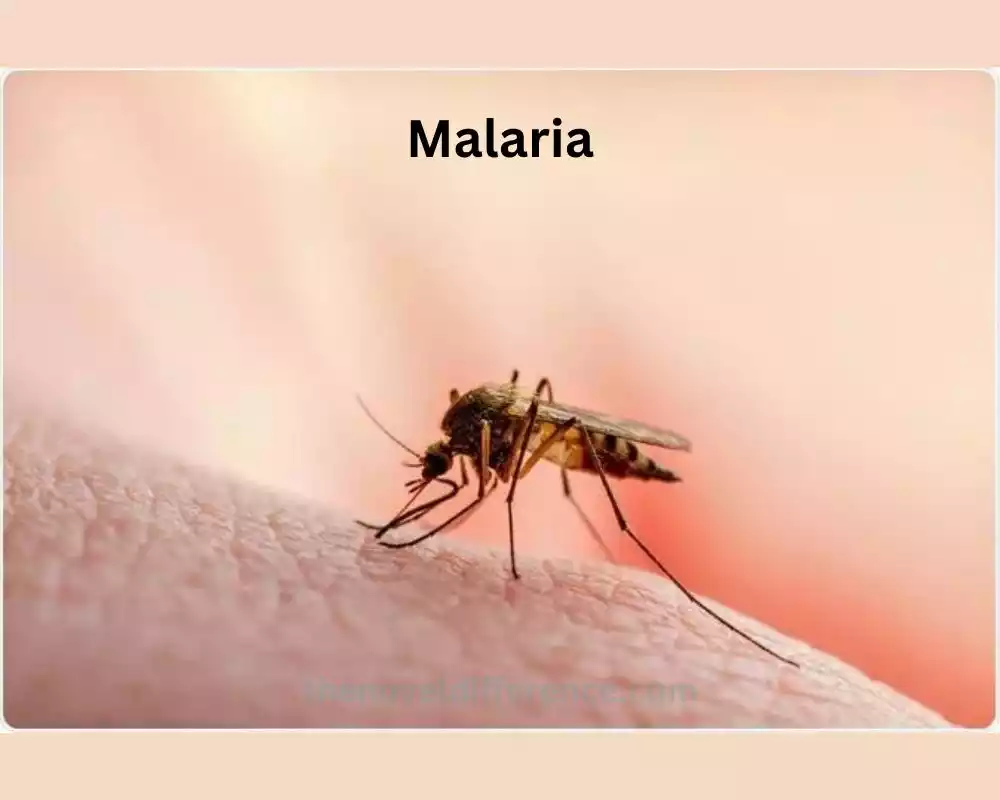
Transmission
Malaria is Primarily Transmitted to Humans Through the Bites of Infected Female Anopheles Mosquitoes. These mosquitoes become infected by feeding on the blood of individuals who have malaria parasites circulating in their bloodstream.
When an infected Mosquito Bites a Person, It Injects Sporozoites, Which Are the infective Form of the Malaria Parasite, Into the Person’s Bloodstream. The sporozoites travel to the liver, where they mature and multiply inside liver cells. This initial Phase of infection in the Liver is Asymptomatic and Can Last From Several Days to Several Weeks, Depending on the Species of the Malaria Parasite.
After the parasites have multiplied in the liver, they are released into the bloodstream as merozoites. The merozoites invade red blood cells, where they continue to multiply, leading to the characteristic cyclic fevers and symptoms associated with malaria. Some malaria parasites can also form sexual forms called gametocytes, which can be taken up by mosquitoes during a blood meal.
When another mosquito bites an infected person and ingests blood containing gametocytes, the parasites undergo sexual reproduction within the mosquito’s midgut, resulting in the formation of sporozoites. These sporozoites migrate to the mosquito’s salivary glands, ready to be injected into a new human host during the mosquito’s subsequent blood meal. This completes the transmission cycle of malaria.
It’s important to Note That Malaria Transmission Can Also Occur Through Other Means, Although They Are Less Common.
These include:
1. Transfusion of infected blood: Malaria parasites can be transmitted through blood transfusion if the donated blood contains the parasites.
2. Organ transplantation: If an organ from an infected donor contains malaria parasites, they can be transmitted to the recipient.
3. Mother-to-child transmission: Pregnant women with malaria can transmit the infection to their unborn babies (congenital malaria) or during delivery.
It’s worth emphasizing that malaria cannot be transmitted through casual contacts, such as touching or hugging an infected person, or through respiratory droplets like some other infectious diseases. The primary mode of transmission is the bite of infected mosquitoes.
Geographic distribution
Malaria has a Wide Geographic Distribution, With the Highest Burden of the Disease Occurring in Tropical and Subtropical Regions. the Distribution of Malaria is influenced by Factors Such as Climate, the Presence of Suitable Mosquito Vectors, and Socioeconomic Conditions.
Here are Some Key Points Regarding the Geographic Distribution of malaria:
1. Sub-Saharan Africa: The Majority of Malaria Cases and Deaths Occur in Sub-Saharan Africa, Particularly in Countries Such as Nigeria, the Democratic Republic of Congo, Uganda, and Mozambique. Plasmodium Falciparum, the Most Deadly Malaria Parasite, is Prevalent in This Region.
2. Asia: Malaria is also endemic in parts of Asia, including countries such as India, Indonesia, Myanmar, and Papua New Guinea. Different species of malaria parasites, including P. vivax and P. falciparum, are found in various regions of Asia.
3. Latin America: Malaria transmission occurs in several countries in Central and South America, including Brazil, Colombia, Venezuela, and Peru. The predominant species in this region is often P. vivax, although P. falciparum can also be present.
4. Middle East: Malaria is present in some countries in the Middle East, such as Afghanistan, Iran, and Yemen. The distribution is generally localized and influenced by local ecological and socio-economic factors.
5. Other regions: Malaria also exists in parts of the Caribbean, Oceania (including Papua New Guinea and the Solomon Islands), and some countries in Eastern Europe.
It’s important to Note That the intensity of Malaria Transmission Can Vary Within Countries, With Higher Transmission Occurring in Rural Areas Compared to Urban Areas.
Efforts to control and eliminate malaria have resulted in significant progress in some regions, leading to a reduction in the number of Challenges such as drug resistance, insecticide resistance, and limited access to healthcare and interventions that continue to pose obstacles in malaria-endemic regions.
Travelers Visiting Areas With Malaria Transmission Are Advised to Take Preventive Measures, Such as Using Bed Nets, Taking Antimalarial Medications as Prescribed, and Minimizing Mosquito Bites Through the Use of Insect Repellents and Protective Clothing. Public health efforts focus on targeted interventions, such as vector control, early diagnosis and treatment, and research for new tools and strategies to combat the disease.
What is West Nile Virus?
West Nile Virus (WNV) Is a Viral infection Primarily Transmitted to Humans Through the Bites of infected Mosquitoes. It belongs to the Flavivirus genus and is commonly found in birds. West Nile Virus Was First Identified in the West Nile Region of Uganda in 1937 and has Since Spread to Various Parts of the World.
1. Transmission: Mosquitoes become infected with the West Nile virus by feeding on infected birds. They can then transmit the virus to humans and other animals through subsequent bites. WNV can also be transmitted through blood transfusions, organ transplantation, and from mother to child during pregnancy, childbirth, or breastfeeding. However, mosquito bites are the primary mode of transmission.
2. Geographic Distribution: West Nile virus is found in many parts of the world, including Africa, Europe, the Middle East, North America, and Asia. The virus has become established in various regions, with periodic outbreaks occurring in specific areas. The distribution and intensity of West Nile virus activity can vary from year to year and between different regions.
3. Symptoms: Most people infected with West Nile virus do not develop any symptoms and remain asymptomatic. Approximately 20% of Infected individuals May Experience Mild Flu-Like Symptoms, Including Fever, Headache, Fatigue, Muscle Aches, Joint Pain, Rash, and Swollen Lymph Nodes. in Rare Cases, Particularly Among Older Adults and individuals With Weakened immune Systems, Severe Neurological Complications Such as Encephalitis (inflammation of the Brain) or Meningitis (inflammation of the Lining Around the Brain and Spinal Cord) Can Occur.
4. Diagnosis and Treatment: Diagnosis of West Nile virus infection is typically based on clinical symptoms and confirmed through laboratory testing, such as detecting the presence of antibodies or the virus itself in blood or cerebrospinal fluid samples. There is no specific antiviral treatment for WNV infection, and management focuses on supportive care to relieve symptoms. Severe cases may require hospitalization for close monitoring and specialized medical interventions.
5. Prevention: Prevention of West Nile virus infection primarily involves mosquito control measures. This includes reducing mosquito breeding sites, using insect repellents, wearing protective clothing, and employing mosquito control methods such as insecticide spraying. Public health agencies also monitor and respond to outbreaks, provide education on personal protective measures, and implement strategies to reduce human-mosquito contact.
6. Public Health Significance: West Nile virus is considered a significant public health concern, particularly during periods of increased transmission. It can Cause Severe Illness and Even Death, With Older Adults and individuals With Weakened immune Systems at Higher Risk of Complications. Surveillance, Early Detection, and Public Awareness are Crucial for Effective Control and Prevention of West Nile Virus infections. It’s important to Note That While West Nile Virus is a Notable Mosquito-Borne Disease, It is Distinct From Other Mosquito-Borne Diseases Such as Malaria, Dengue Fever, and Zika Virus infection, Each Caused by Different Viruses and Exhibiting Unique Clinical Features.
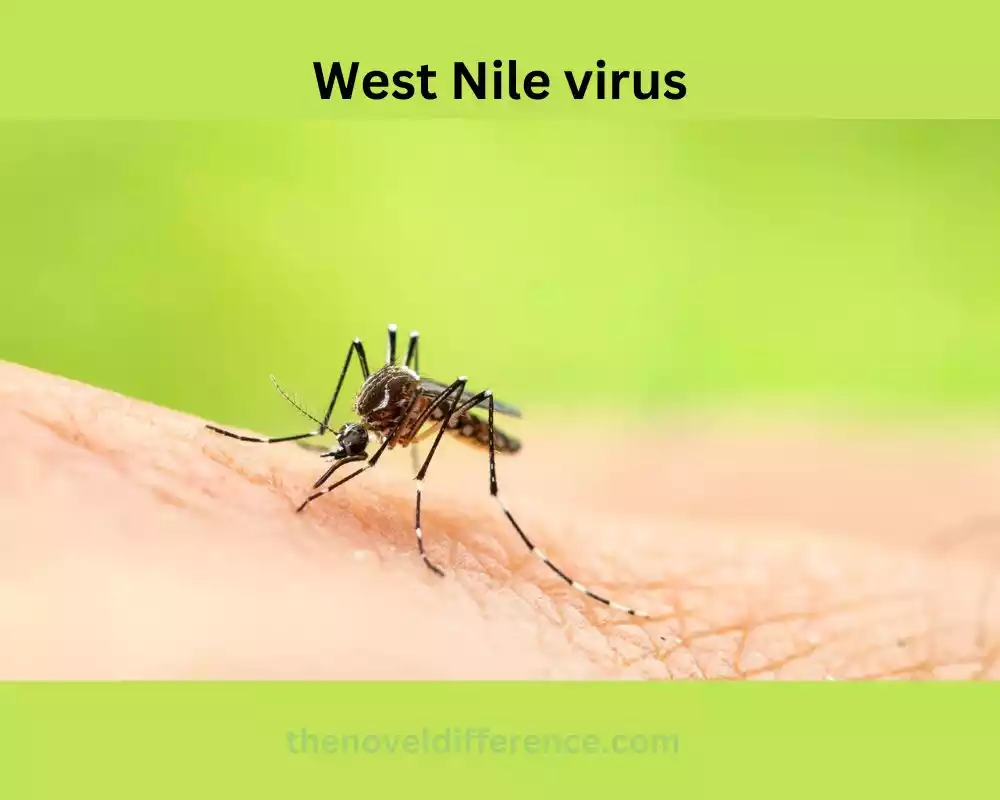
Transmission
West Nile Virus (WNV) is Primarily Transmitted to Humans Through the Bites of infected Mosquitoes. Mosquitoes become infected with the virus by feeding on infected birds that act as reservoir hosts for WNV. The virus then replicates within the mosquito’s body, allowing it to be transmitted to other hosts, including humans and animals, during subsequent blood meals.
The specific mosquito species that serve as vectors for West Nile virus vary depending on the region. The Primary Vector is the Culex Mosquito, Particularly Culex Pipiens and Culex Quinquefasciatus. These Mosquitoes are Widespread and Commonly Found in Urban and Suburban Areas. In other Parts of the World, Different Mosquito Species May Play a Role in Transmitting the virus. When an infected Mosquito Bites a Human, the Virus is injected into the Person’s Bloodstream Along With the Mosquito’s Saliva.
The virus then multiplies and can potentially cause infection. It’s important to Note That West Nile Virus is Not Directly Transmitted From Person to Person, Except in Rare Cases of Mother-to-Child Transmission During Pregnancy, Childbirth, or Breastfeeding, as well as Through Blood Transfusions or Organ transplantation. It’s Worth Mentioning That Not All Mosquitoes Carry West Nile Virus, and Even in Areas Where the Virus is Present, Only a Small Proportion of Mosquitoes May Be Infected.
Not Everyone Who is Bitten by an Infected Mosquito Will Develop Symptoms or Become Ill. The Risk of Severe Illness Tends to Be Higher Among Older Adults and Individuals With Weakened immune systems. Preventing Mosquito Bites is Key to Reducing the Risk of West Nile Virus infection.
Measures to prevent transmission include using insect repellents containing DEET, wearing protective clothing such as long sleeves and pants, and staying indoors during peak mosquito activity times, particularly around dawn and dusk. Additionally, reducing mosquito breeding sites by eliminating standing water and implementing mosquito control measures, such as larviciding and insecticide spraying, can help reduce mosquito populations and limit transmission.
Public health agencies and organizations also play a crucial role in monitoring the spread of the West Nile virus, conducting surveillance on mosquito populations and human cases, and implementing control measures when necessary. Education and public awareness campaigns are important for promoting personal protective measures and informing communities about the risks and prevention strategies associated with West Nile virus infection.
Geographic distribution
West Nile Virus (WNV) is Found in Various Regions of the World, With Its Distribution Varying by Country and Even Within Specific Regions.
Here is an Overview of the Geographic Distribution of West Nile Virus:
1. North America: West Nile Virus Was First Identified in North America in 1999 and Has Since Become Endemic in Many Parts of the Continent. It is Present Throughout the United States, Including All 48 Contiguous States, as well as in Canada and Mexico. Outbreaks of West Nile virus occur periodically in different regions, with varying intensity and geographic spread.
2. Europe: West Nile virus is endemic in several European countries, particularly in the eastern and southern regions. Countries such as Greece, Italy, Romania, Serbia, and Russia have reported human cases and WNV activity in birds and mosquitoes. Outbreaks and sporadic cases have been documented in various European nations.
3. Africa: West Nile virus was first identified in Uganda in 1937, and the virus is widespread in many parts of Africa. It Has Been Reported in Numerous Countries Across the Continent, including Uganda, Kenya, South Africa, Senegal, and Egypt. Africa serves as a significant reservoir for the virus, with various mosquito and bird species contributing to its circulation.
4. Middle East: West Nile virus is prevalent in parts of the Middle East, including countries like Israel, Iran, Iraq, Jordan, and Saudi Arabia. The virus circulates among birds, mosquitoes, and occasionally humans in these regions.
5. Asia: West Nile virus activity has been reported in several countries in Asia, including India, Pakistan, China, and parts of Southeast Asia. The distribution and intensity of WNV transmission can vary within these countries, with regional outbreaks occurring periodically.
It’s important to Note That the Presence and intensity of West Nile Virus Activity Can Change Over Time Due to Various Factors, Including Ecological Conditions, Bird Migration Patterns, and Human interventions. Not all individuals infected with the West Nile virus develop symptoms or seek medical attention, which can impact the reporting and awareness of cases in certain regions.
Surveillance efforts, mosquito control measures, and public health interventions are implemented to monitor and mitigate the spread of West Nile virus. Additionally, travel advisories and guidelines may be issued to inform individuals traveling to regions with ongoing WNV transmission about the potential risks and preventive measures to take.
Understanding the Geographic Distribution of the West Nile Virus is important for Public Health Authorities, Healthcare Professionals, and individuals to Assess the Risk of Infection, Implement Appropriate Preventive Measures, and Respond Effectively to Outbreaks or Increasing Activity in Specific Areas.
Differences Between Malaria and West Nile Virus
Malaria and West Nile Virus (WNV) Are Two Distinct Infectious Diseases Caused by Different Pathogens and Transmitted by Different Vectors.
Here are the Key Differences Between Malaria and West Nile Virus:
1. Causative Agents:
• Malaria: Malaria is caused by parasites of the Plasmodium genus, with Plasmodium falciparum being the most severe and deadly species affecting humans. Other Species That Cause Malaria in Humans Include Plasmodium Vivax, Plasmodium malaria, and Plasmodium ovale.
• West Nile Virus: West Nile virus is caused by a virus belonging to the Flavivirus genus. It is an RNA virus with various strains circulating globally.
2. Transmission:
• Malaria: Malaria is primarily transmitted to humans through the bites of infected female Anopheles mosquitoes. It Can Also Be Transmitted Through Blood Transfusion, Organ Transplantation, or From an Infected Mother to Her Unborn Child.
• West Nile Virus: West Nile virus is primarily transmitted to humans through the bites of infected mosquitoes, primarily of the Culex species. Rare Cases of Transmission Through Blood Transfusion, Organ Transplantation, or From Mother to Child During Pregnancy, Childbirth, or Breastfeeding Have Been reported.
3. Geographic Distribution:
• Malaria: Malaria is Endemic in Many Tropical and Subtropical Regions of the World, Particularly Sub-Saharan Africa, but It Also Occurs in Parts of Asia, Latin America, and the Middle East.
• West Nile Virus: West Nile Virus has a Wider Geographic Distribution, Including Regions of Africa, Europe, the Middle East, North America, and Asia. The distribution and intensity of WNV activity can vary from year to year and within specific regions.
4. Symptoms:
• Malaria: Symptoms of malaria typically include fever, chills, headache, muscle aches, fatigue, and nausea. Severe Cases Can Lead to Complications Such as Organ Failure, Anemia, Cerebral Malaria, and Death.
• West Nile Virus: Most people infected with West Nile virus do not develop symptoms. About 20% of infected individuals May Experience Mild Flu-Like Symptoms, While a Small Proportion May Develop Severe Neurological Complications Such as Encephalitis or Meningitis.
5. Treatment and Prevention:
• Malaria: Malaria can be treated with antimalarial medications, and the specific drug regimen depends on the Plasmodium species involved and the drug resistance patterns in the region. Prevention includes vector control measures such as bed nets, indoor residual spraying, and chemoprophylaxis for travelers to endemic areas.
• West Nile Virus: There is no specific antiviral treatment for West Nile virus infection. Management focuses on supportive care for symptomatic individuals. Prevention involves mosquito control measures, such as using repellents and reducing mosquito breeding sites.
6. Public Health Impact:
• Malaria: Malaria is a major global health problem, particularly in low-income countries, causing a significant burden of morbidity and mortality.
• West Nile Virus: West Nile virus can cause outbreaks and sporadic cases, with the severity of the disease varying across individuals. While it can lead to severe complications, the overall impact on public health is generally lower compared to malaria.
Understanding these differences between malaria and West Nile virus is important for accurate diagnosis, appropriate treatment, and effective implementation of preventive measures for each respective disease.
Similarities Between Malaria and West Nile Virus
While Malaria and West Nile Virus (WNV) Are Distinct Diseases, There Are a Few Similarities Between them:]
1. Mosquito-Borne Diseases: Both Malaria and West Nile Virus are Transmitted to Humans Through the Bites of Infected Mosquitoes. Mosquitoes serve as vectors, carrying the respective pathogens and transmitting them to humans during blood feeding.
2. Geographic Distribution: Malaria and West Nile Virus diseases have a wide geographic distribution, occurring in multiple regions around the world. While the Specific Countries and Regions Affected May Vary, Both Malaria and West Nile Virus Have Been Reported in Various Continents, Including Africa, Asia, Europe, the Middle East, and the Americas.
3. Seasonal Patterns: Malaria and West Nile Virus diseases can exhibit seasonal patterns of transmission. Malaria and West Nile Virus Infections May Be More Prevalent During Certain Times of the Year When Mosquito Populations Are Higher or Environmental Conditions Favor Transmission.
4. Potential for Severe Complications: While the majority of malaria cases can be successfully treated, both malaria and West Nile virus infections can lead to severe complications, particularly in certain populations. Severe Forms of Malaria Can Result in Organ Failure, Cerebral Malaria, and Death, While West Nile Virus Can Cause Severe Neurological Complications, Including Encephalitis and Meningitis.
5. Public Health Impact: Malaria and West Nile Virus diseases have a significant impact on public health, particularly in areas where they are endemic. Malaria is a Major Global Health Concern, Causing a High Burden of Morbidity and Mortality, Especially in Tropical and Subtropical Regions. While the overall impact of West Nile Virus May Be Lower Compared to Malaria, Outbreaks of the Virus Can Have Public Health Implications and Require Surveillance, Prevention, and Control measures.
It’s important to Note That Despite These Similarities, Malaria and West Nile Virus Are Caused by Different Pathogens, Have Different Vectors, Exhibit Distinct Clinical Features, and Require Specific Diagnostic and Treatment Approaches. Understanding the similarities and differences between Malaria and West Nile Virus diseases is crucial for accurate diagnosis, appropriate management, and effective prevention and control strategies.
Conclusion
Malaria and West Nile Virus are distinct diseases caused by different pathogens and transmitted through different vectors. While Malaria is caused by a parasite and primarily transmitted by Anopheles mosquitoes, West Nile Virus is caused by a virus and transmitted by mosquitoes, particularly of the Culex species.
These diseases also differ in their geographical distribution, symptoms, diagnostic methods, and treatment options. Understanding these differences is essential for accurate diagnosis, appropriate treatment, and effective prevention strategies. By staying informed and taking necessary precautions, we can minimize the risks associated with both Malaria and West Nile Virus.

